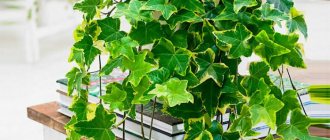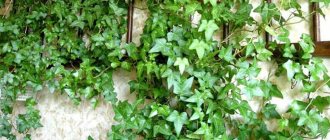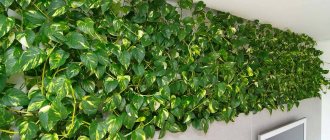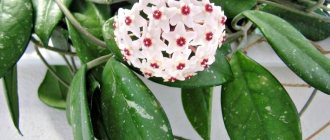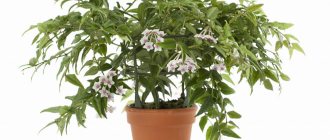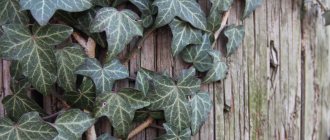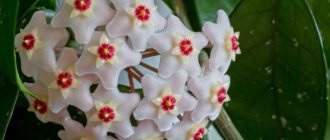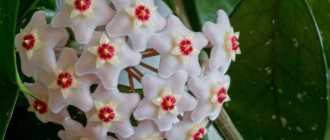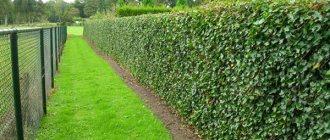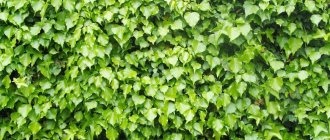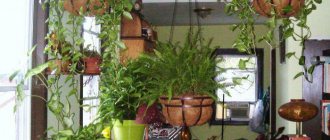Family Araliaceae – Araliaceae
A small genus of evergreen vines includes 15 species, distributed in the dry and humid subtropics of Europe, Asia and Africa. Ivy grows in shady forests, along ravines, gullies, and climbs rocks and trees to a height of up to 20 m. There are many forms of this beautiful plant with glossy elongated forms, healthy and strong. It grows in shade and sun, can withstand drafts and can be kept in an unheated room. Thanks to its characteristics, Ivy has earned a good, time-tested reputation among gardeners as a popular and unpretentious ornamental plant.
Hedera helix
The dark green leaves are leathery, smooth, shiny, 3–7 lobed, with a network of light veins. The leaves are much smaller than those of the previous species; there are also varieties with leaves of various shapes and patterns. The flowers are small, five-membered, greenish-yellow and may have a white or cream border and a mosaic pattern of the same color. Collected in umbrella-shaped inflorescences. The fruits are blue-black berries.
Ivies are extremely variable. They will grow as ampelous or climbing ones, depending on your desire. This magnificent green vine with a creeping or climbing stem attached to the support using sucker roots is widely used in vertical gardening. Forms dense greenery on supports, trellises and trellises. With proper care, ivy will live quite a long time as a houseplant.
Ivy
Ivy , or Hedera (Hedera) is a small genus of evergreen climbing or terrestrial creeping woody plants in the Araliaceae family, numbering 17 species. The natural habitat of ivy is the western, central and southern parts of Europe, Macaronesia, North-West Africa, Central Asia, Japan and Taiwan.
These are powerful and large evergreen vines with long shoots. On flat surfaces they remain ground cover plants, not exceeding a height of 5-20 cm, while reaching up to 50 m in length. When meeting vertical supports such as trees, rocks or artificial structures, the stems can rise to a height of up to 30 m. Juvenile (young) shoots are thin and flexible, with small aerial roots that stick to the substrate as they climb. The leaves on these shoots are also juvenile, lobed, and arranged alternately. On the thicker mature flowering shoots, which form high in tree canopies or on the tops of mountain cliffs where they are exposed to bright sunlight, the plants are already self-supporting, without roots, and have mature, unlobed, heart-shaped leaves.
|
|
The leaf blades are leathery and slightly uneven at the edges, this helps remove excess moisture from the leaves in humid living conditions.
In autumn, small greenish-yellow bisexual flowers with five small petals, collected in umbrella-shaped inflorescences, appear on the tops of the branches. The flowers are very rich in nectar.
The fruit is a greenish-black, dark purple, rarely yellow berry with a diameter of 5-10 mm with 1-5 seeds, ripening in late winter or mid-spring. The fruits are eaten by birds, which spread the seeds. In this way, the Hedera was able to repopulate large areas where it had disappeared during the Ice Age.
Ivies have important ecological significance, providing a source of nectar and fruits at a time when other plants no longer have them.
The berries are moderately toxic to humans. The leaves contain falcarinol, which can cause severe contact dermatitis.
The medicinal properties of ivy are known; the extract of its leaves has an expectorant, mucolytic and antispasmodic effect due to the presence of saponins from the group of triterpene glycosides.
Ivy is a relict plant, one of the surviving representatives of the ancient laurel forest (laurisilva), which previously covered most of the Mediterranean coast. Such a forest grew in humid areas of the subtropics with relatively stable moderate temperatures. Around 10,000 years ago, as the climate became harsher and drier, these forests disappeared and survived only in a few island and oceanic enclaves in the North Atlantic.
North African and North Atlantic cheder species are closely related. Until recently, it was believed that common ivy (Hedera helix) was the only type of ivy. But recent studies have shown that there are several closely related species that arose due to vicariance, when populations of the same species are isolated from each other due to geographic fragmentation of the range to such an extent that genetic exchange between them becomes impossible .
Species differ in the details of the shape and size of leaves (mainly juvenile ones) and the structure of leaf trichomes (epidermal cells, outgrowths that form pubescence on plant organs), and to a lesser extent the size and color of berries and flowers. The number of chromosomes also varies. The basic diploid number is 48, some species are tetraploid with 96, others hexaploid with 144, and there are also octaploids with 192 chromosomes.
Ivies are adaptable to many conditions, but prefer the moist microclimates of cloud forests, stream valleys, and coastal mountain ridges with well-drained, rich soils. Like many vines, they like their roots to be in cool shade and their crowns to be in full sun. These are long-lived plants, whose age can reach more than 400 years.
In their natural habitats, where they harmonize well with the surrounding vegetation, ivies are very popular and widely cultivated as ornamental plants. In Europe, they are used to landscape walls and unsightly facades of buildings. Several dozen varieties were selected that differ in shape, size and color of leaves, color of stems, growth pattern, etc.
Possessing great adaptability, headers will grow where conditions are similar to European ones. They easily spread beyond cultivated gardens, invade nearby parks, and, lacking the natural pests and diseases that keep them in check in their homeland, crowd out native flora. In some countries where they were introduced by humans (Australia, New Zealand, North America), ivies are recognized as weeds and invasive species, often subject to cultivation bans.
Common ivy (Hedera helix) is the most common species and is native to most of Europe and Western Asia. The Latin species name helix comes from the ancient Greek word meaning “turn” and is associated with the ability of ivy to tightly wrap around any support. It can often be seen on the walls of houses, tree trunks in gardens and in the wild throughout its habitat.
|
|
It is an evergreen climbing shrub, reaching a height of 20-30 m if it finds support (trees, rocks, walls), or is a ground cover if there are no vertical surfaces. It rises with the help of aerial roots with pads that adhere tightly to the base. The leaves are leathery, alternate, 5-10 cm long, on petioles 1.5-2 cm, of two types: five-lobed juveniles on creeping and climbing shoots, and heart-shaped adults on flowering stems that form high in the crown of trees or on top of rocks under the influence of direct sun. The small, greenish-yellow flowers, very rich in nectar, appear from late summer to late autumn, providing food for bees and many other insects. The fruits are purple-black, sometimes orange-yellow berries 6-8 mm in diameter with 1-5 seeds, ripen in late winter and serve as an important food source for many birds, but are poisonous to humans.
The area of natural distribution to the north usually does not extend beyond the winter isotherm of -2°C, although the species itself is quite winter-hardy and can withstand frosts down to -23°C.
The closely related species Hedera canariensis and Hedera hibernica are similar in appearance, but differ in the number of chromosomes, which prevents them from freely interbreeding.
Irish or Atlantic ivy (Hedera hibernica) is native to the Atlantic coast of Europe. Often found under the name Hedera helix subspecies hibernica.
An evergreen plant, reaches a height of 20-30 m on vertical supports, or spreads along the ground. The bark on young shoots is green, becoming gray with age. The leaves are glossy, lightly ribbed and dark green above, the underside is pale green, with 5 triangular lobes on juvenile shoots and oval on fruiting shoots. Flowering occurs between September and October. The fruits are blue-black berries.
The species is widespread in horticulture, thanks to which it has expanded beyond its natural habitat. Irish ivy has become a weed in parts of North America with mild winters, and recent research has shown that the majority of invasive populations in this region consist of this species rather than common ivy, as previously thought. The plant can become a problem in the garden, quickly colonizing hedges and trees if left unchecked.
Fatshedera Lize (x Fatshedera lizei). Photo: Natalia Semenova
The only proven hybrid with ivy is Fatshedera Lizei (x Fatshedera lizei), obtained from crossing Japanese fatsia (Fatsia japonica) and Irish ivy (Hedera hibernica). This hybrid was obtained in France at the beginning of the 20th century by the Liese brothers and was never repeated; it is maintained through vegetative propagation.
Algerian ivy (Hedera algeriensis) is native to the North African coast and coastal mountains, where the climate is cooler and condensation provides a wetter habitat.
|
|
This is a large, fast-growing climbing shrub. Stems are reddish. The leaf blade on flowering shoots is oval-rhombic, 12-20 cm long and 5-12 cm wide, strongly serrated or slightly lobed (3-5 lobes) on sterile (juvenile) stems. Umbrella-shaped inflorescences, consisting of 13-15 small pubescent flowers, are formed on the tops of only fertile shoots.
Its various varieties are widely used in horticulture and have been grown in the UK since 1838. Algerian ivy requires constant soil moisture, but is more tolerant of dry environments than most related species and can withstand drought better than other heders. Tolerates low temperatures (down to -2°C) better than island species of the same latitudes, such as Hedera canariensis, Hedera maderensis, Hedera azorica or Hedera cypria.
Algerian ivy arose from a common ancestor growing in the forests of the Mediterranean and is closely related to Hedera maroccana, Hedera iberica and Hedera canariensis.
Canary ivy (Hedera canariensis) is widespread in the Canary Islands and is also found in North Africa.
The shoots of this climbing shrub are able to climb on suitable surfaces to a height of 20-30 m, or grow as ground cover if there are no vertical supports. Young stems are greenish, greenish-brown, sometimes reddish or violet-tinged, becoming gray or grey-brown with age. The leaves are wide, 5-20 cm, dark green, glossy and slightly leathery, with 1-5 lobes. The flowers are greenish, the berries are round and black when ripe.
In warm climates it grows faster than the closely related species H. hibernica and H. helix. Grown in gardens and used in flower arrangements.
Colchian or Persian (Hedera colchica) is native to the Near and Middle East.
It is a woody evergreen shrub; its green stems reach a height of 30 meters if there is suitable support, or spread along the surface of the ground. The leaves are the largest among heders, up to 15 cm wide and up to 25 cm long, of two types: five-lobed on juvenile shoots and heart-shaped on flowering shoots. In warm climates it grows faster than other types of hedera. It blooms from late summer to late autumn with small greenish flowers, very rich in nectar and collected in large quantities in umbrella-shaped inflorescences. They serve as food for bees and other insects. The spherical black berries with 1-5 seeds ripen in late winter and are food for many birds.
Popular varieties: Dentata variegate (Dentata aurea, Variegata), Sulfur Heart (Paddy's Pride).
Colchian ivy (Hedera colchica) Sulfur Heart
Cyprus ivy (Hedera cypria) is endemic to the island of Cyprus.
It is a slow-growing evergreen, reaching a height of 20-30 m, or ground cover. More often found at altitudes above 400-650 m in shady rocky forests along rivers. Small alternate leaves on long petioles, of two types, five-lobed juvenile leaves on creeping and climbing stems, and laurel-shaped adult leaves on fertile stems. It is distinguished from other heders by its unique pattern of white and gray veins on the leaves and red stems.
This species is closely related to the Pastukhov ivy growing in the immediate vicinity.
Pastukhov's ivy (Hedera pastuchovii) comes from Eastern Transcaucasia, where it is found in the lowlands, in the lower and middle mountain zones, most often on the edges and clearings of forests.
A rare plant, listed in the Red Book of Russia and the Red Book of the Republic of Dagestan.
A climbing shrub that attaches to tree trunks using adventitious roots or grows along the ground. Unlike many other species, it does not spread along rocks.
The leaves are thin, glossy, light green, entire or with wavy edges, 10-12 cm long and 6-9 cm wide, often round, rarely oblong-elliptic, deeply or finely lobed, heart-shaped or wedge-shaped at the base. Single or collected in several pieces, umbrella-shaped inflorescences, consisting of 5-20 flowers, are covered with yellow-brown scales on top. The berries are black, 6-10 mm.
The plant is used for vertical gardening.
Iberian ivy (Hedera iberica) is native to the Iberian Peninsula and Northern Morocco, where it grows on tree trunks, rocks and slopes or spreads along the ground. Previously considered as a subspecies of Madeira ivy (Hedera maderensis var. iberica).
It is a perennial shrub with greenish-brown stems up to 30 m, sometimes colored red or purple, and covered with aerial roots. The leaves are wide, leathery, with 1-5 lobes. The flowers are small, greenish-yellow, collected in large numbers in umbrella-shaped inflorescences. Flowering occurs from April to December. The fruits turn black when ripe. Grown in gardens and used for flower arrangements.
Madeira ivy (Hedera maderensis) - native to the island. Madeira in the Atlantic Ocean, where it is often found growing on the slopes of rocks, tree trunks or simply on the surface of the soil. Like other heders, it is a perennial climbing shrub, reaching 20-30 m in length. The stems are green or greenish-brown, sometimes reddish or purple, with aerial roots. The leaves are wide, from 5 to 20 cm, slightly leathery, with 1-5 lobes. From April to December, small, greenish-yellowish flowers appear, collected in umbrella-shaped inflorescences at the ends of fertile shoots. The fruits are black, spherical. Grown in gardens and used in floristry.
About growing - in the article Ivy in indoor conditions.
Photo: Rita Brilliantova
Features of care
Temperature: can tolerate various temperature conditions, grows well at temperatures from 14 to 24°C. At colder temperatures, growth is slow, but the color of the leaves is brighter; at high temperatures, the opposite is true.
Lighting: the plant is undemanding to light, does not like direct sunlight and grows best in partial shade. Good lighting is helpful in winter, but avoid direct sun in summer.
Humidity: Moderate watering is needed all year round. When carrying out them, you should focus not on formal intervals in days, but on the condition of the soil - it should never dry out completely. In summer, regular spraying is necessary, the rest of the time it is advisable to spray occasionally.
Soil: a mixture of turf and humus soil with peat and sand in a ratio of 2:1:1:1 is optimal, but other options are possible. You can use ready-made universal soil mixtures.
Nutrition: ivy should be fed depending on the condition of the plant (if growth stops).
Reproduction: stem cuttings
Other care: For vertical gardening, it needs support. The plant needs to be replanted every 2 years. The presence of aerial roots allows the plant to be given unusual shapes, such as ring-shaped. To do this, part of two shoots near the tops with roots is buried in the upper part of the future ring, and the top itself remains free. On the sides, the stems are tied to a support or rope fastenings. You can get an original plant by grafting it, for example, onto a tall Aralia rootstock.
News:
Article date: 04/03/2007 (updated 11/19/2007)Family: Araliaceae.
Homeland: temperate, tropical and subtropical mountain regions of Eurasia.
Flowering: rarely indoors.
Growth: fast.
Light: bright, diffused, without direct sunlight, can grow in partial shade, but in species with variegated leaves, the original color is lost. In the autumn-winter period, good lighting is necessary; additional lighting can be used using fluorescent lamps.
Temperature: moderate. In the spring-summer period, within 18-25°C, at night not lower than 15°C. In the autumn-winter period, the optimal temperature is within 12-15 ° C, but it can winter at higher temperatures, in which case regular spraying is necessary. Variegated forms are more thermophilic.
Watering: spring-summer - plentiful. Winter-autumn - moderate. The earthen ball should not be excessively waterlogged, but not too dry either.
Air humidity: on summer and hot days, spraying is useful. In winter, when kept at room temperatures, spraying is also useful.
Feeding: during the spring-summer growing season, every 10 days the ivy is fed alternately with mineral and organic fertilizers.
Pruning: bare shoots are shortened by pruning. From time to time the ends of the stems need to be pinched, but so that the side shoots remain.
Dormant period: from October to February, the optimal temperature is 12-15 ° C, higher for variegated leaves, good lighting, moderate watering.
Transplantation: young ones are transplanted every year or as needed, adults every 2-3 years.
Reproduction: by apical and middle stem cuttings.
The genus Ivy (HederaL.) - photo - according to various sources, contains from 6 to 15 species of plants of the Araliaceae family, growing in the mountainous regions of the Mediterranean (up to the Caucasus), in Western and Central Europe, in the western Himalayas and East Asia. They grow in forests, climbing rocks, rocky places and climbing trees to considerable heights.
Representatives of the genus are evergreen woody climbing vines that climb along a support with the help of aerial adventitious sucker roots. The roots appear in large numbers on the side of the stem facing the soil or support, forming dense brushes. With age, the long stems become very thick and woody, turning into thick, twisted trunks. Leaves are alternate, entire or 3-5-lobed; characterized by diversity. The flowers are bisexual, 5-membered, small, greenish-yellow, in solitary or umbellate inflorescences collected in a raceme: they bloom in autumn. The fruits are berry-shaped. Ivy plants are good fall honey plants. The fruits contain saponins and other glycosides used in medicine.
Ivy is one of the most common decorative leafy indoor and garden plants. If ivy is grown as a vine, it will quickly fill the gaps between shoots, especially if you choose fast-growing forms. Types of ivy that have aerial sucker roots easily climb wallpaper, panels, etc., but there are forms of ivy that do not have light roots - such plants need support. Ivies are used not only for vertical gardening; they can be grown as hanging plants in hanging baskets or as ground cover. Common ivy (H. helix) is most often cultivated. Ivy blooms rarely in cultivation, at the age of 10-12 years. The flowers are inconspicuous, small, collected in umbrella-shaped inflorescences, with an unpleasant odor. After flowering, berries are formed that are very poisonous. Therefore, even if your plant produces buds, you should not leave them.
Ivy is very shade tolerant. The shape of the leaves allows plants to optimally arrange themselves without shading each other and at the same time using the full light flux - this phenomenon is called leaf mosaic. There are variegated forms of ivy - green sections of the leaves alternate with white or yellowish ones devoid of chlorophyll, which can have the form of strokes, borders, or follow the contours of large veins.
Kinds:
Canary ivy (Hedera canariensis Willd.). Synonym: Common ivy subspecies Canary (Hedera helix L. subsp. canariensis (Willd.) Cout.) , in various Russian sources it is mentioned as Algerian ivy (Hedera algeriensis) , in various online publications there is an erroneous Latin name Hedera canadensis . Grows in northern Africa, Portugal.
A vigorous, creeping or climbing plant, the leaves are large with white or yellow intensely colored spots.
There are various varieties. The most famous variety is Gloire de Marengo , or Variegata - photo. A tall climbing plant with reddish stems and large, three-lobed, bare, glossy leaves with whitish-greenish strokes along the edges. Striata variety with leaves that are light green or yellow in the center.
P. colchis (H. colchica (K. Koch) K. Koch). Naturally grows in the humid subtropics of Transcaucasia, Asia Minor, Iran. A powerful, liana-like, evergreen shrub, climbing along a support to a height of up to 30 m. Sterile shoots are thin, with short sucker roots, fruiting shoots are thicker and hairy. The leaves are large, up to 25 cm long, different in shape, shiny, leathery, mostly whole, less often three-lobed, green, with a specific nutmeg smell when rubbed. Blooms in autumn. Inconspicuous flowers are collected in umbrella-shaped inflorescences. Berry-shaped, spherical, black fruits ripen in the summer of next year. It grows faster than common ivy, but is less frost-hardy. For good development it needs fresh, fertile soil and semi-shaded locations. Used in vertical gardening.
There are different varieties: Dentata Variegata - with almost oval-shaped leaves and whitish-yellowish edges. Sulfur Heart - photo - with large, light green leaves with yellowish-greenish stripes along the veins, slightly curled leaves along the edges. Arborescens - photo - upright growing small variety, with slightly drooping light green shoots and green, oval-lanceolate leaves
P. common (Hedera helix L.) . An evergreen plant with a creeping, climbing stem. The leaves are alternate, simple, 3–7-lobed, leathery, glabrous, shiny, dark green, with a network of lighter veins. The flowers are small, 5-membered, bisexual, greenish-yellow, in umbellate inflorescences. The fruits are spherical blue-black berries 8–10 mm in diameter. Does not bloom indoors. Homeland - Western and Southern Europe, North Africa, Western and Central Asia. Extremely variable species. More than 100 forms are known in culture, differing in size, color and leaf shape.
There are different varieties and varieties of photos: with almost oval and rounded leaves, variety Harald , various. scutifolia ; with star-shaped leaves - different. sagittaefolia ; with corrugated edges - arazn. cristata , cultivar Ivalace ; smooth-edged, pure green varieties Annette, Green Ripple and Chicago ; varieties with almost yellow leaves - Eva and Mona Lisa ; with spotted leaves - varieties Jubilee , Glacier ; diff. marmorata – with three-lobed dark green leaves with a marbled whitish-yellowish pattern; variety Kholibra a - is distinguished by its miniature size and the same small three-lobed leaves with a whitish pattern.
P. Pastukhovaa (N. pastuchovii Woronow). Homeland - Caucasus, Middle East. Protected in a number of nature reserves in the Caucasus. In floodplain and low-mountain deciduous forests on fertile soils. Shade-tolerant. Decorative. Recommended for landscaping in the Moscow region. The species and garden forms with white or yellow-variegated leaves are very decorative.
| Hedera canariensis | Hedera colchica Dentata Variega | H. pastuchovii var. cypria |
Plant care:
Ivies prefer indirect light. They do not tolerate direct sunlight well, but (especially variegated forms) prefer a well-lit place and do not like changes in location in relation to the light source. Green ivy varieties can be classified as shade-tolerant, but it is still advisable to provide them with a bright place. With a lack of light, variegated forms lose their original color. In winter, a brighter location is needed; with a lack of light and high air temperatures, the plant stretches out. You can create additional lighting using fluorescent lamps, placing them above the plant at a distance of 50-60 cm, for at least 8 hours a day.
In the spring-summer period, ivy prefers moderate air temperatures, ranging from 18-25 C, at night not lower than 15 C. In summer, the plant can be placed outdoors, but it should be protected from sunlight, precipitation and drafts. It is advisable to keep the autumn-winter plant at a temperature of 12-15C, but it can overwinter at a higher temperature, in which case regular spraying is necessary. Variegated forms are more thermophilic. In winter, make sure that the leaves of ivy growing on the windowsill do not touch the window glass closely - they can become hypothermic.
Watering in spring and summer is plentiful, as the top layer of the substrate dries out; some gardeners water it after the earthen clod dries out, but prolonged (a day or two) drying out is very harmful. In the autumn-winter period, watering is careful (especially when kept at a temperature of 12-15C), watered moderately, two to three days after the top layer has dried, and with a small amount of water. When watering, it is necessary to take into account that overmoistening the substrate can lead to rotting of the roots and death of the plants.
A large mass of leaves evaporates a lot of moisture, ivy responds very gratefully to daily spraying - the color of the leaves becomes brighter, the white veins stand out more clearly on them, the stem begins to branch and is overgrown with a fringe of adventitious roots. These roots often take root in various places outside the pot, and it is usually not possible to remove them without damaging the shoot. Spraying should be done with soft, well-settled or filtered water. You can periodically wash the plant or wipe the leaves with a damp cloth; using special wax to add shine to the leaves is not advisable.
During the spring-summer growing season, every 10 days the ivy is fed alternately with mineral and organic fertilizers. In winter, fertilizing is reduced to 1 time per month. Sometimes frequent feeding leads to the fact that the leaves become very large and the plant loses its decorative appeal. A number of gardeners recommend foliar feeding instead of fertilizing the soil.
Since ivy is supported by the power of its roots, it is not able to catch on thread, wire or a smoothly planed wood frame. The best and most natural support for ivy will be a piece of wood with bark covered with cracks and irregularities. In order for the ivy to attach itself to the support, it must be sprayed occasionally (adventitious ivy roots grow poorly in dry air). The shoots will have to be tied to all other supports with twine. From time to time the ends of the stems need to be pinched, but so that the side shoots remain. Bare shoots are shortened by pruning. Cut shoots can be used for cuttings.
Every two years in the spring, the ivy is transferred to a larger pot; replanting is not advisable for an adult plant. Young ones pass every year or as needed, adults every 2-3 years. You can plant several young plants in a pot, then the composition will be more magnificent.
Ivy loves light soil; it is best to use a mixture based on peat and humus or equal parts of turf, leaf, humus soil, peat and sand, or a ready-made substrate for decorative foliage plants. It is necessary to ensure good drainage - ivy loves moist soil, but does not tolerate waterlogging and acidification of the soil.
Easily propagated by apical and middle stem cuttings throughout the year. Cuttings easily take root in a moist substrate (peat and sand, or leaf soil and sand) or sand. The cuttings are covered with a glass cap or a transparent plastic bag, constantly sprayed and ventilated regularly. Cuttings root well when using a greenhouse with bottom heating, and cuttings also root well with formed aerial roots. After rooting, ivy cuttings are planted in pots, several at a time, in an earthen mixture consisting of equal parts of turf and leaf soil, humus, peat and sand. In order for the plant to branch better, pinching is carried out several times a year, and bare shoots are shortened by pruning. Young plants are replanted every year, then after 2-3 years.
When propagating by central stem cuttings, cut off the entire shoot with 8-10 leaves. It is placed horizontally in a groove in the sand to a depth of 1.5-2 cm, leaving the leaves outside. On the tenth day, underground roots form from aerial roots on the stem near the buds. The tip of the shoot begins to grow. Dormant buds in the leaf axils do not germinate. After two weeks, the shoot is removed from the sand, cut into cuttings with one leaf and roots, after which three cuttings are planted in 7-centimeter pots, where new shoots develop from dormant buds. Several shoots of ivy can be grafted (into a split or behind the bark) onto an adult Fatsia japonica plant (also from the Araliaceae family) - you will get a very original “weeping” tree, with flowing branches.
Precautionary measures:
During flowering, ivy has an unpleasant and strong smell (compared to the smell of rotten meat), which attracts insects for pollination, in particular flies. Therefore, it is advised to remove them if buds appear. Black ivy berries are very poisonous.
Common ivy leaves are also poisonous: they can cause inflammation of the stomach and intestines, vomiting, and contact dermatitis.
Possible difficulties:
The leaves dry out, turn brown and die when the room temperature is too high, when the air humidity is low, when there is insufficient watering, or when watering is irregular, as well as when they are damaged by spider mites.
Small leaves, open twisted stems. The reason is a lack of light, although the old leaves at the base of the ivy stem tend to fall off with age. Also, ivy leaves turn yellow and fall off due to lack of moisture.
The leaves lose their variegated color due to lack of light. Varieties of ivy with different colors acquire a uniform green color when there is a lack of light. Another reason is that the pot is too cramped.
Damaged by: scale insects and spider mites.
Healing properties:
The leaves and fruits of ivy contain the glycoside hederin and saponins. In small doses, ivy preparations are used for chronic bronchial catarrh. In folk medicine, it is also used for diseases of the liver and gall bladder, gout, and rheumatism. Externally - for calluses, warts, polyps, purulent wounds caused by burns, and as an anti-inflammatory for leucorrhoea in women. Ivy is used as an astringent, antitumor, laxative, and emetic.
Authors of the article: Marina and Alexander Mityaev
Discuss the article and care on the forum
Hedera, or a photo of our ivy - we admire it together!
How to propagate ivy (hedera) - discussed on the forum
Share the link
Materials used in the article:
Indoor floriculture / R. Milevskaya, Y. Vies. - Mn.: Book House, 2005. - 608 p., ill.
Dr. D.G. Hessayon. All about indoor plants. 2nd edition revised. Moscow “Kladez-Books”, 2004
https://f-lohmueller.de/botanic/Araliaceae/Hedera/Hedera01.htm
https://commons.wikimedia.org/wiki/Image:Hedera_canariensis_Variegata1.jpg
https://www.mobot.org/gardeninghelp/plantfinder/Plant.asp?code=U190
https://www.glasshouseworks.com/trop-gh.html
https://www.esveld.nl/htmldia/h/hecarb.htm
https://de.wikipedia.org/wiki/Bild:Illustration_Hedera_helix0.jpg
https://www.dkimages.com/……../Hedera-pastuchovii-var-cypria/Hedera-pastuchovii-var-c-1.html
